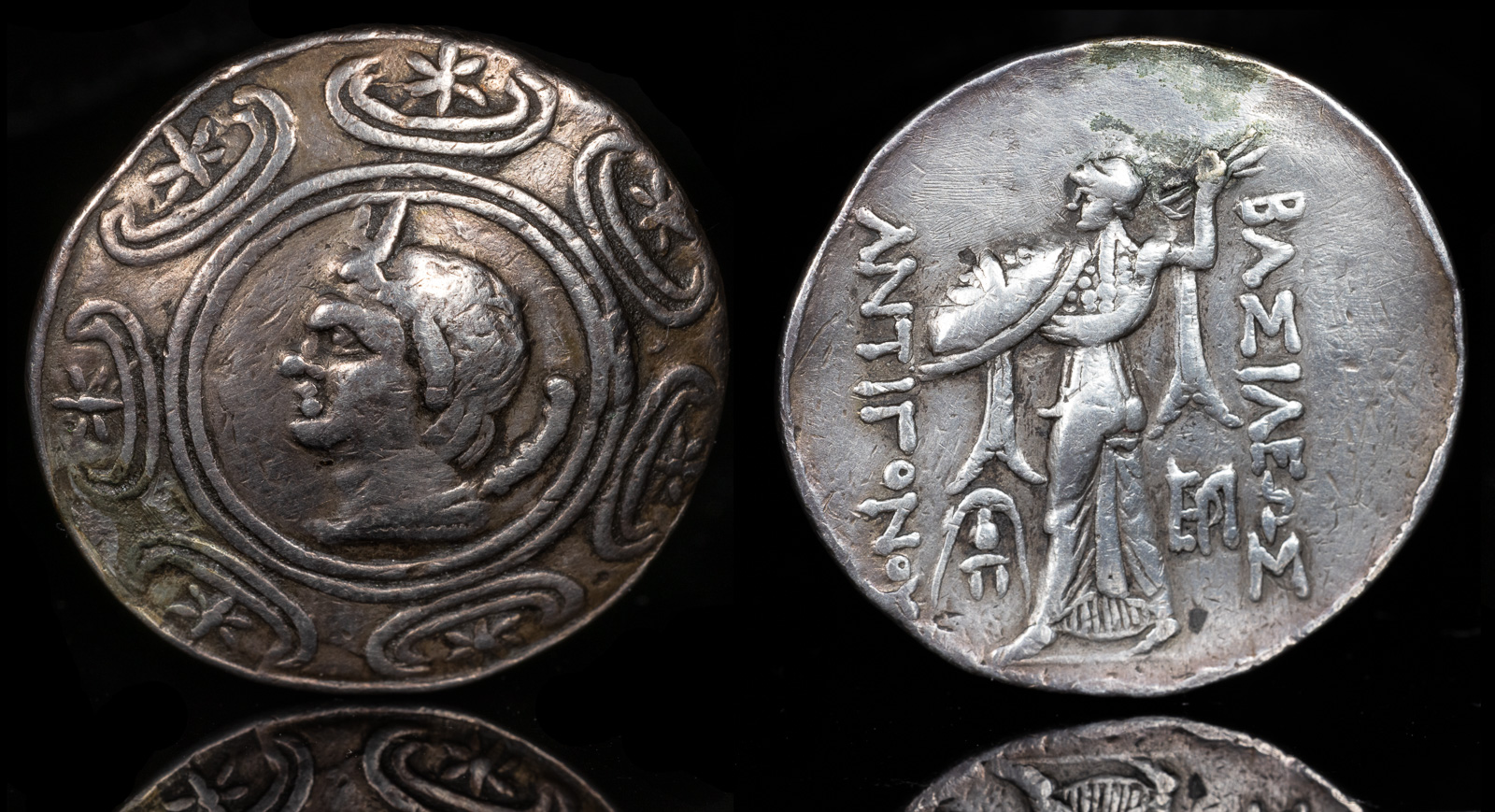
Kings of Macedon, Antigonos II Gonatas (277/6-239 BCE)
Amphipolis, c. 274/1-260/55 BCE
AR Tetradrachm 31mm, 16.85g, 3h
Horned head of Pan l., lagobolon over shoulder, in the centre of a Macedonian shield
R/ Athena Alkidemos advancing l., preparing to cast thunderbolt; crested Macedonian helmet to inner l., monogram to inner r.
HGC 3, 1042; Panagopoulou 2000 Period I, Group I, #7 (O3, R07) (this coin)
Ex L. de Nicola, Rome Sep 1974
It was Macedon in 277 BCE. The entire country was in chaos. There were Gauls everywhere. One couldn’t walk in the street without witnessing this horde pillaging. The Gauls cut in line at the supermarkets, ravaged the countryside, and had horrible manners.
Something needed to be done, and when the Gauls attacked the holy city of Delphi, the Greeks had had enough. This time, it was the Aetolians who stepped to the front. The Aetolian League was an exclusive club of cities in ancient Greece, who had lately made some rather poor decisions in arguing with Alexander the Great. But with him out of the picture, they were now the big boys in town. They were also the inventors of the thermos, named for their capital.
The Aetolian League teamed up with Antigonos II Gonatas. Antigonos was the rock star of the day, since he enjoyed tremendous fame through both sides of his family. His father was Demetrios I Poliorketes, which means “besieger of cities.” Every time Athens or Rhodes invited Demetrios to dinner, there would be a huge flotilla of tiremes outside the city, and all the inhabitants would say “not again, Demetrios!” Demetrios‘ father was Antigonos I Monophthalmos, the famous general of Alexander the Great who finally perished on the battlefield against the combined might of Seleukos, Lysimachos, and Ptolemy at the age of 81.
Antigonos’ mother was Phila, a highly-respected woman who was the daughter of a poorly respected man in Kassander, who himself was son of Alexander III’s regent in Macedonia, Antipater.
All of this fame was great for Antigonos II Gonatas, but he lacked much of an army to retake his birthright of Macedonia, so he joined with the more powerful Aetolians. Together, they strode out to take on the fierce Gauls.
In an amazing bit of fortune, the work turned out to be easier than thought. While everyone was encamped at night, anxious to fight the next day, an earthquake hit during a lightning storm. The resulting chaos caused the Gauls to panic, and they started killing each other while the Aetolians and Antigonos II Gonatas watched the whole spectacle with popcorn. The next day, they mopped up what remained.
Now, although Antigonos wasn’t the best military leader, being the product of royalty had enabled him to achieve his MBA (Macedonian Business Administration), and one skill he learned there was brand marketing. To build his brand, he advertised the whole ordeal by taking Pan – the Deity of Mischief – as his emblem and placing it in the center of all his coins. The Aetolians, who supplied the majority of troops, are still relatively unknown to this day. The Gauls eventually moved to France and became the center of modern day haute couture.
Approximate year of birth of Antigonos II to Demetrios Poliorketes and Phila.
Antigonos II installs the tyrant Kleon at Sikyon.
Antigonos II seizes Macedonia from Alexander V.
Antigonos II remains in Greece where he squashes a revolt by Boeotia while Demetrios Poliorketes moves to seize the territories of Lysimachos.
Demetrios Poliorketes and Antigonos II take Thebes after a siege. Huge siege engines are used to break its walls.
Pyrrhos takes Beroea and the army of Demetrios Poliorketes deserts him. At news of the defeat, Phila, the mother of Antigonos II, commits suicide by poison.
Demetrios Poliorketes surrenders to Seleukos and is taken prisoner. Pyrrhos and Lysimachos divide Macedonia, leaving Antigonos II without a kingdom.
Demetrios Poliorketes dies while imprisoned by Seleukos I Nikator. Antigonos II Gonatas continues the Antigonid dynasty.
Antigonos II marches against Ptolemy Keraunos to retake Macedonia, but is defeated.
The Aetolian League along with Antigonos II Gonatas defeat an invasion of Gauls.
Amphipolis falls under the control of Antigonos II Gonatas after his victory over the Gauls at the Battle of Lysimachia.
Antigonos II defeats the Gauls at the Battle of Lysimacheia.
Antigonos II defeats Sosthenes, who ran Macedonia during the Macedonian Interregnum.
Antigonos II drives Ptolemy Epigonos out of Macedonia.
December
Antigonos II has control over most of Macedonia.
Pyrrhos of Epiros attacks Argos, which is helped by Antigonos II, and is killed there when an old woman throws a brick on him.
Antigonos II installs the tryant Aristippos the Elder at Argos.
Aristodamos the Good is installed as Tyrant of Megalopolis by Antigonos II Gonatas.
Athens is convinced by Chremonides to join Sparta in declaring war on Antigonos II.
Antigonos II blockades Athens and destroys a temple to Poseidon between it and Megara. Ptolemy II sends a fleet to break the blockade.
Antigonos II installs the tyrant Abantidas at Sikyon.
Athens and Sparta make peace with Antigonos II, who maintains his hold on Greece.
Ptolemy II‘s interference in Greece results in war with Antigonos II.
Antiochos II signs an agreement with Antigonos II against Ptolemy II and the Second Syrian War begins.
Kos comes under Antigonos II Gonatas.
The Second Syrian War ends. Ptolemy II cedes land to Antiiochos II and Antigonos II remains in mastery of Greece. Antiochos II takes control over Ephesos, Samos, and Miletos.
Antigonos II installs the tyrant Paseas at Sikyon.
Antigonos II installs the tyrant Nikokles at Sikyon.
Aratos of Sikyon removes the tyrant Nikokles, who Antigonos II had installed. Antigonos II attempts to bribe Aratos but is unsuccessful.
Alexander, the son of Krateros, rises in revolt against Antigonos II. Alexander is poisoned.
Antigonos II regains control over Corinth.
Antigonos II dies. Demetrios II becomes king of Macedon and continues the Antigonid dynasty.